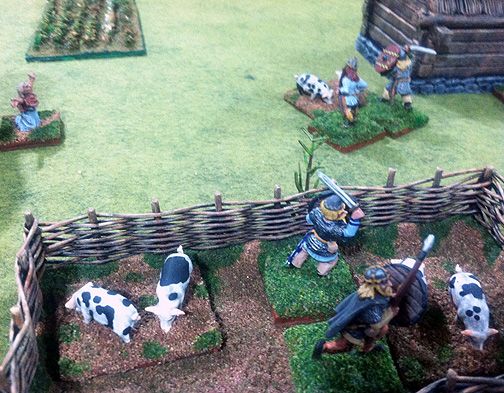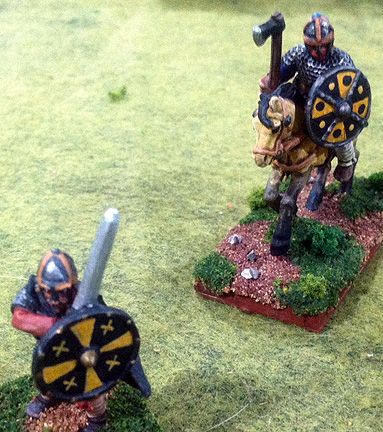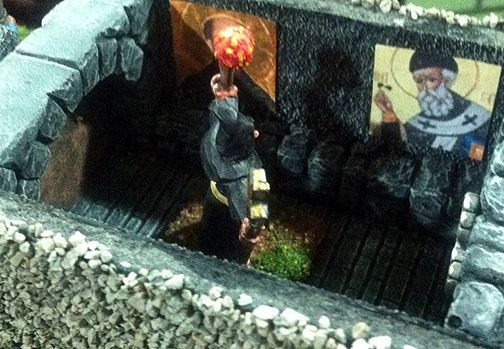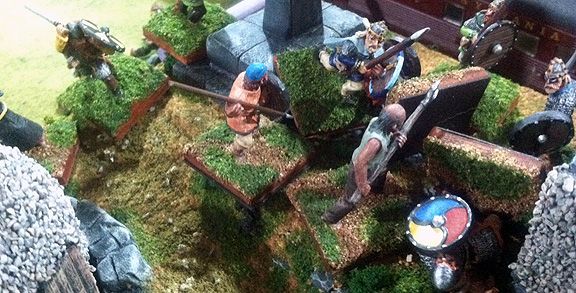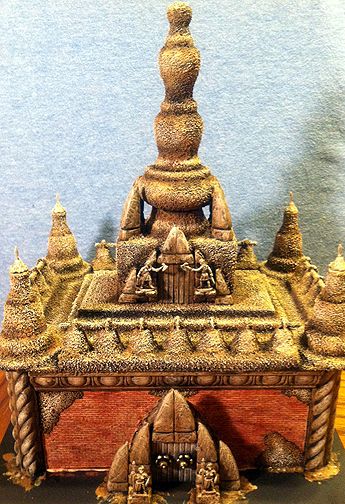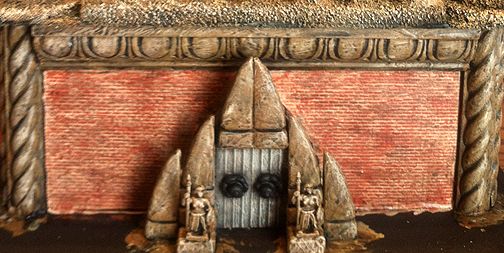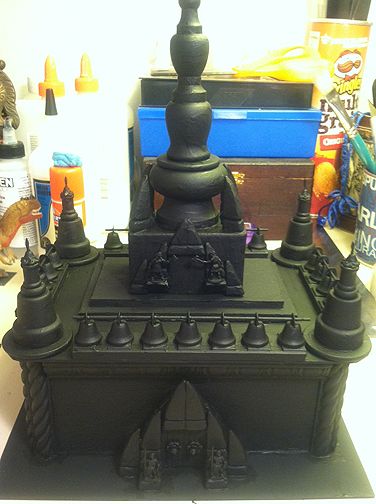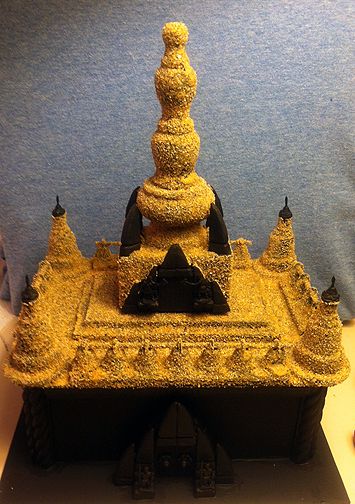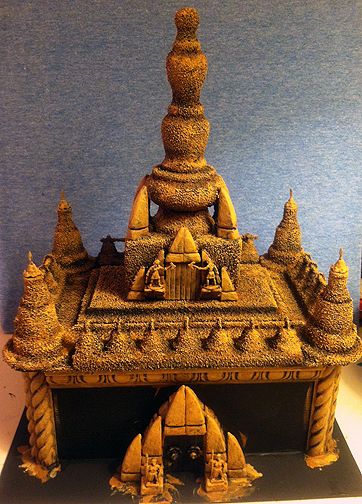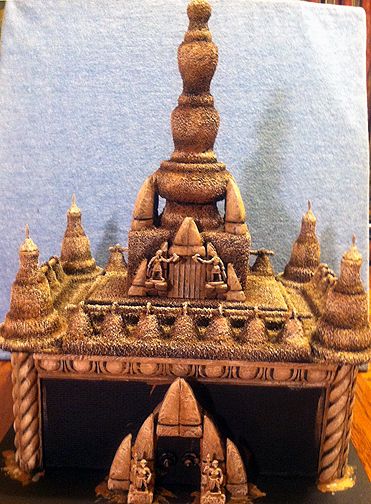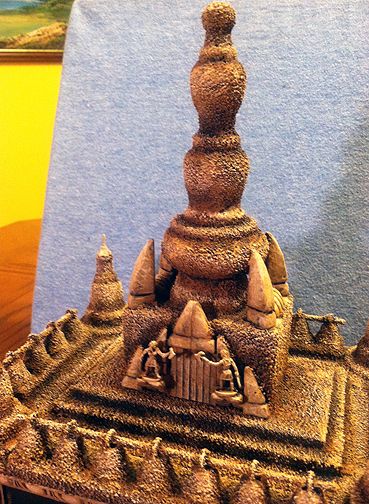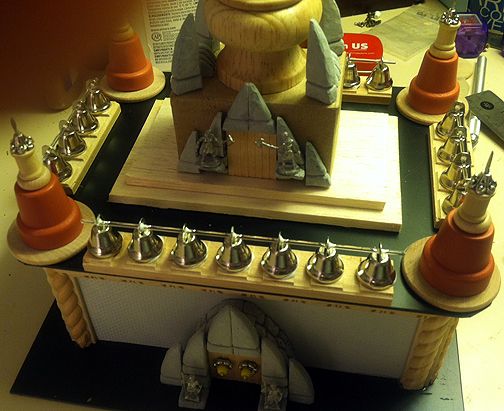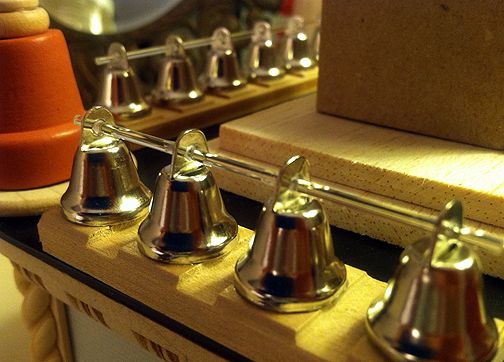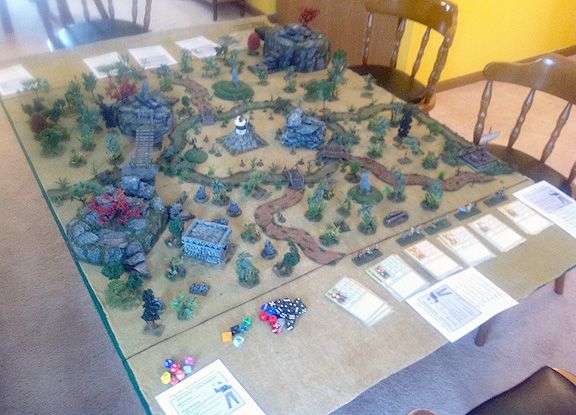 |
| An overview of the most elaborate table I've ever set up: the river encircles an island in the center of the table. White steam marks where the cannibal cookpot has Brother Virigi on "simmer". The cliffs and pathways represent the various entry points for the five archeological factions. |
The drum beats and howling from the pygmy cannibal village unnerved the archeologists as they crept towards it. Through the trees, they could see the glow of flames. Would they be too late? Would the Portuguese monk, Brother Virigi, already be the village dinner by the time they arrived? Caution and haste were called for at both times.
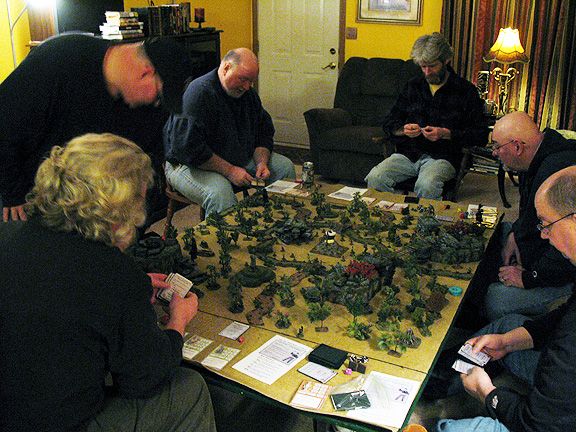 |
| The players study their initial fortune cards and try to map out a strategy to be the first to rescue Brother Virigi |
On the river, Harris McLeod poled his hastily-built raft to shore, motioning his companions to follow him. The monk knew the location to the hidden city, and God alone knew the riches he could find there for the British Museum! Not far away, Pierre Fournereau hissed instructions to his men, "Zee monk must be rescued at all costs! Only with him, will we find zee ruins we seek..." Far above them, Von Jaeger and his Germans surveyed the scene from a rocky cliff. Giant stone idols loomed out of the jungle -- doubtless showered with riches by the savages of the jungle. Hurrying down the path leading to the cannibal village, a step ahead of the Germans, Dakota Smith and his friends also were eyeing the same giant stone heads, and the riches that may lay hidden near them. Another group of fortune hunters, Lady Shannon's Irish, looked down from a rocky hill at the two paths ahead of them. Should they cross the perilous looking rope bridge -- the quickest way to the village -- or detour to the temple below them and search it? Meanwhile, hidden in the jungle, three agents of the Order of the Fire Coral watched the approach of the westerners -- vowing the foreign devils would not succeed.
The leader of the secret martial arts society, Opay, saw the Irish head towards the temple and acted first. He found a way into the temple and discovered the skeleton on the floor. The satchel of the long-dead foreigner carried maps, he saw, maps that must not fall into the hands of the foreign devils! Before he could escape the temple, though, the rugged Irish mercenary Ryan O'Shea burst through the door and the two struggled over the satchel. Eventually, Opay disengaged and dove out through the window. There, he had to dodge a fusilade of shots fired by Ryan's companions. Unscathed, he scampered off into the jungle. Here was one clue to the Forbidden City's location that the Westerners would never find!
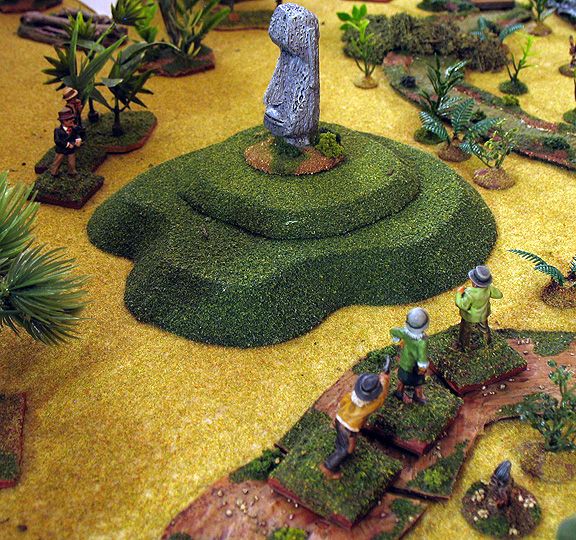 |
| Both the German and American archeologist leagues close in on one of the stone idols. Dakota Smith's band would spend the game frustrating their rival Germans, snatching treasure after treasure from under their nose. |
On the other side of the village, Dakota Smith and his pal Harold found their way to one of the giant stone idols. Together, they pried out the immense ruby eyes, and disappeared into the brush as the sound of German voices drew near. Von Jaeger, cursing that Fraulein Blucher had fallen and knocked herself out climbing down from the cliff, let off a stream of Teutonic obscenities as he saw his rival Dakota disappear into the jungle. The empty eye sockets of the idol seemed to be mocking him. He and Otto hurried out onto the path, where they saw Dakota Smith and Dolly Flanders clambering up a cliff path towards another one of the savage's stone idols. Chuckling evilly, he and Otto Tulmann fired bursts of automatic fire above the Americans, which set loose a rockslide. Dakota reached for Dolly's hand as she slipped, but missed and watched her fall, knocked senseless onto the rocks below. "Zat is for Frau Blucher, mein American..."he growled. Dakota leapt up and blazed away at the Germans with his six-shooter, who ducked, then fired back. Harold Fortwine, who had made it to the bridge leading to the village, hearing the firefight, turned and pulled out his revolver and joined in, as well.
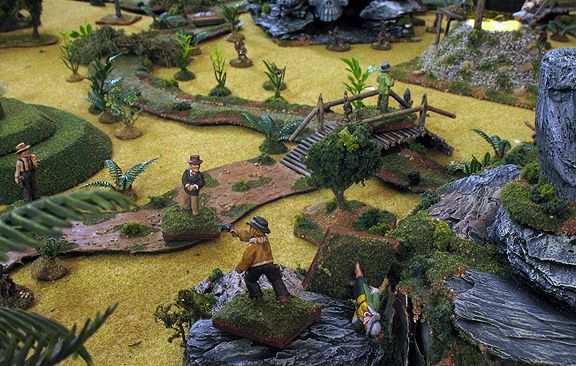 |
| Dakota blazes away at Von Jaeger and Otto Tulmann below, while Dolly takes a tumble from the rocky cliff path |
Harris McLeod and Maj. Speke-Eastman had looted an idol of their own when they were surprised by the Fire Coral agent Jaz Minh leaping onto the path next to them. Inexplicably, all were too stunned to attack each other. Instead, the speedy martial artist raced up the path towards the cannibal village. Dumbfounded, the two Brits looked at each other, "Bloody Hell...?" Harris cocked his head, and asked, "Say, my good major, have you seen Clara?"
 |
| A "Parley" fortune card made for this comic moment as Jaz Minh leaps out from the underbrush at Harris McLeod and Maj. Speke-Eastman, only to have all concerned stare at each other until she darted off. |
The major looked back on the path and shook his head. "She was behind us just a moment ago..." In the woods a ways off, Harris' niece lay unconscious. They pygmies looming above her noticed the two Brits, and turned to stalk them next.
 |
| Tex becomes my rope bridge's first (and probably not last) victim as his cowboy boots break through the rotted slats and send him hurtling towards the river below |
Meanwhile, Lady Shannon's American mercenary, Tex, swallowed and tread softly out onto the rope bridge. His cowboy boots seemed to sink into the soft, almost rotted wood until there was a crash. He caught himself, though, and slowly dragged himself onto the next wooden slat. Beneath him, the waters of the jungle river writhed with evil dark shapes. Tex watched them for a few seconds, then pulled himself up and raced for the end of the bridge. There was another crash, and the American screamed as he fell towards the river below.
 |
| Cue climactic orchestra music: With a display of athletic prowess, French leader Pierre Fournereau kicks aside pygmies and rescues Brother Virigi from the cookpot |
There was a chorus of shouts and the drumming ceased when Pierre and his Frenchmen came charging across a bamboo bridge into town. Pygmies ran towards them, but Pierre kicked them aside. Dr. Lambert swatted another with his stout leather briefcase, while Jacques Nero blazed away with his shotgun, scattering the crowd of cannibals. Pierre hurled himself across the village and up the wooden plank that led to the boiling and hissing cookpot. He picked up the two pygmies who were poking the flames with their spears and hurled them to the ground. With a display of superhuman strength, the athletic French archeologist snapped the leather bonds holding Brother Virigi and lifted him bodily out of the cookpot. The monk was flushed red and looked slightly scalded, but seemed not unduly hurt. Pierre half-dragged, and half-carried him back down the plank towards his companions.
 |
| Jaz Minh bravely hurls herself on the three Frenchmen to keep Virigi (and his knowledge of the Forbidden City) out of the hands of the foreign devils |
There was a shout and the martial artist Jaz Minh raced towards Pierre and began kicking and punching the Frenchman, who fended off her blows. There was an even louder shriek of fury, and the pygmies of the village converged on the intruders. Jaz Minh gasped as a pygmy spear laid open her leg. The Frenchmen knocked away pygmies from all sides, gathered up the monk and moved towards the bridge. Pierre handed the monk off to the doctor, and stood as a valiant rearguard, battering aside any pygmies that tried to follow.
 |
| Another agent of the Order of the Fire Coral, Tatko, bravely holds off the Irish leader and sidekick for several turns -- keeping them out of the action |
Not far away, the martial artist Tatko and the Irish fortune hunters Lady Shannon and Ryan were engaged in a fierce brawl themselves. Tatko showed blazing speed in avoiding the attacks of the two Irish. The furious clamor from the village prompted them to break off their melee, and sneak towards the path to investigate. When they saw Dr. Lambert hurrying the monk down the path, they knew the French had been successful. Tatko stepped out onto the path for a clear throw, and zipped two shuriken at the archeologist. Dr. Lambert calmly ducked, then opened his briefcase, pulled out a revolver, and blazed away, wounding Tatko. Lady Shannon and Ryan appeared and both raised their weapons. "The monk comes with us!" they shouted. Lambert trained his revolver on them and fired. The Irish clucked in disbelief, "Och, bad decision, laddie..." They aimed at the doctor and squeezed their triggers..."Click! Click!" Out of ammunition -- both of them! The two let out a stream of curses in Gaelic as the Frenchman scooted past them, laughing.
 |
| Clutching the monk's arm, Dr. Lambert runs the gauntlet of Tatko, Lady Shannon, and Ryan -- aided by not one but two "Out of Ammo" fortune cards |
Meanwhile, far away in the jungle, Dakota Smith was definitely not laughing as he fled from the angry orangutan, whose frustrated howls rivaled those of the pygmies. Although he had not rescued the monk, he was somewhat relieved to see the French had done so. Now, all he would have to do would be to follow the French to the hidden city! He'd calmly finished looting the last of the pygmy idols and had been sneaking off into the jungle when he'd surprised the massive ape. His shots back at it did not seem to deter it from its chase, though. Eventually, he blundered onto the path, where he met Harold Fortwine, carrying Dolly Flanders. "What's that sticking out of your tail end, Harold?" Dakota asked.
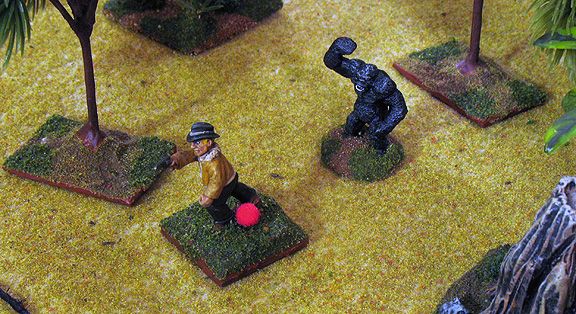 |
| A comic end to the tale was a great ape chasing a wounded Dakota Smith out of the jungle |
The burly academic grunted, "Cursed pygmy arrow!" Behind them, they heard more howls, though they could not tell if it was pygmies or apes. The two giggled and fled off into the jungle, not sticking around to find out.
Our third game of Pulp Alley was a blast. I had six players -- five archeological leagues, and one martial arts society whose job is to frustrate the objective of the others. Each team except for the martial arts society had a Leader, Sidekick, and Ally. Humorously, four of the five allies ended up being knocked down and out -- and all by the play of Fortune Cards. Both Frau Blucher and Dolly Flanders took tumbles on perilous cliff paths, while Tex was the first character to try to cross my rope bridge (and failed). British Clara was ambushed by pygmies in the woods early on. The only Ally to survive was the French Jacques Nero.
The French won the scenario, with the heroic charge led by their leader, Pierre Fournereau. They were really the only faction who made a concerted effort to go for the major plot point -- Brother Virigi stewing in the cookpot. All of the others were distracted by the minor plot points of idols and temples. The Germans in particular, spent the game chasing after Dakota Smith and his band after they snatched a plot point from under their noses. The Irish were also frustrated, but by the Order of the Fire Coral. First, Opay stole the plot point out of the temple just ahead of them. Then Tatko was a one-man wrecking and dodging crew, holding off the Irish leader and sidekick single-handedly. The Order of the Fire Coral has three sidekicks instead of the Leader/Sidekick/Ally combination. They played masterfully this time. They did not win, as the French had the major plot point, but they prevented the Irish from being a factor. The British succeeded in looting one idol, and seemed content with that. Dakota Smith surprisingly ignored the quick pathway to the village and left it to the French to rescue Brother Virigi, while he went off idol hunting. The Americans snagged two plot points, and escaped off board.
The players all seemed to have a good time...well, except for the Germans! We are getting better at creating the storyline of what happens in each perilous area, and making up what form each challenge takes. In the extremely perilous river island -- the cannibal village -- the perils were simply pygmies rushing at the players. Easier challenges represented lone pygmies, while difficult ones were swarms of them. The systems forces us to tell the story as we go along, and it often turns out to be a fairly hilarious one, too! Seven friends sitting around the table can be pretty ruthless when it comes to thinking of embarrassing things that happened to your characters when they fail challenges...!
The next chapter will find the archeologists finally exploring the hidden city that Brother Virigi had spotted so long ago. Stay tuned to this channel for more thrilling Oriental Adventures with Dakota Smith...!
